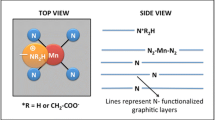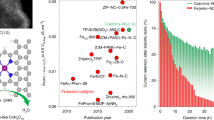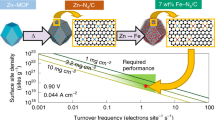Abstract
Platinum group metal (PGM)-free catalysts that are also iron free are highly desirable for the oxygen reduction reaction (ORR) in proton-exchange membrane fuel cells, as they avoid possible Fenton reactions. Here we report an efficient ORR catalyst that consists of atomically dispersed nitrogen-coordinated single Mn sites on partially graphitic carbon (Mn-N-C). Evidence for the embedding of the atomically dispersed MnN4 moieties within the carbon surface-exposed basal planes was established by X-ray absorption spectroscopy and their dispersion was confirmed by aberration-corrected electron microscopy with atomic resolution. The Mn-N-C catalyst exhibited a half-wave potential of 0.80 V versus the reversible hydrogen electrode, approaching that of Fe-N-C catalysts, along with significantly enhanced stability in acidic media. The encouraging performance of the Mn-N-C catalyst as a PGM-free cathode was demonstrated in fuel cell tests. First-principles calculations further support the MnN4 sites as the origin of the ORR activity via a 4e− pathway in acidic media.






Similar content being viewed by others
Data availability
The data that support the findings of this study are available from the primary corresponding author (G.Wu) upon reasonable request.
References
Lefèvre, M., Proietti, E., Jaouen, F. & Dodelet, J.-P. Iron-based catalysts with improved oxygen reduction activity in polymer electrolyte fuel cells. Science 324, 71–74 (2009).
Proietti, E. et al. Iron-based cathode catalyst with enhanced power density in polymer electrolyte membrane fuel cells. Nat. Commun. 2, 416 (2011).
Wu, G. & Zelenay, P. Nanostructured nonprecious metal catalysts for oxygen reduction reaction. Acc. Chem. Res. 46, 1878–1889 (2013).
Gewirth, A. A., Varnell, J. A. & DiAscro, A. M. Nonprecious metal catalysts for oxygen reduction in heterogeneous aqueous systems. Chem. Rev. 118, 2313–2339 (2018).
Chung, H. T. et al. Direct atomic-level insight into the active sites of a high-performance PGM-free ORR catalyst. Science 357, 479–484 (2017).
Wu, G., More, K. L., Johnston, C. M. & Zelenay, P. High-performance electrocatalysts for oxygen reduction derived from polyaniline, iron, and cobalt. Science 332, 443–447 (2011).
Yan, D. et al. Defect chemistry of nonprecious-metal electrocatalysts for oxygen reactions. Adv. Mater. 29, 1606459 (2017).
Gong, K., Du, F., Xia, Z., Durstock, M. & Dai, L. Nitrogen-doped carbon nanotube arrays with high electrocatalytic activity for oxygen reduction. Science 323, 760–764 (2009).
Masa, J., Xia, W., Muhler, M. & Schuhmann, W. On the role of metals in nitrogen‐doped carbon electrocatalysts for oxygen reduction. Angew. Chem. Int. Ed. 54, 10102–10120 (2015).
Liu, J. et al. High performance platinum single atom electrocatalyst for oxygen reduction reaction. Nat. Commun. 8, 15938 (2017).
Zitolo, A. et al. Identification of catalytic sites for oxygen reduction in iron- and nitrogen-doped graphene materials. Nat. Mater. 14, 937–942 (2015).
Jiang, W. J. et al. Understanding the high activity of Fe-N-C electrocatalysts in oxygen reduction: Fe/Fe3C nanoparticles boost the activity of Fe-Nx. J. Am. Chem. Soc. 138, 3570–3578 (2016).
Wu, G. et al. Carbon nanocomposite catalysts for oxygen reduction and evolution reactions: from nitrogen doping to transition-metal addition. Nano Energy 29, 83–110 (2016).
Banham, D. et al. A review of the stability and durability of non-precious metal catalysts for the oxygen reduction reaction in proton exchange membrane fuel cells. J. Power Sources 285, 334–348 (2015).
Ferrandon, M. et al. Stability of iron species in heat-treated polyaniline–iron–carbon polymer electrolyte fuel cell cathode catalysts. Electrochim. Acta 110, 282–291 (2013).
Wu, G. Current challenge and pÿerspective of PGM-free cathode catalysts for PEM fuel cells. Front. Energy 11, 286–298 (2017).
Wu, G. et al. Performance durability of polyaniline-derived non-precious cathode catalysts. ECS Trans. 25, 1299–1311 (2009).
Choi, C. H. et al. Stability of Fe-N-C catalysts in acidic medium studied by operando spectroscopy. Angew. Chem. Int. Ed. 54, 12753–12757 (2015).
Kramm, U. I., Lefevre, M., Bogdanoff, P., Schmeisser, D. & Dodelet, J. P. Analyzing structural changes of Fe-N-C cathode catalysts in pem fuel cell by mossbauer spectroscopy of complete membrane electrode assemblies. J. Phys. Chem. Lett. 5, 3750–3756 (2014).
Goellner, V. et al. Degradation of Fe/N/C catalysts upon high polarization in acid medium. Phys. Chem. Chem. Phys. 16, 18454–18462 (2014).
Walling, C. Fenton’s reagent revisited. Acc. Chem. Res. 8, 125–131 (1975).
Wang, X. X. et al. Nitrogen-coordinated single cobalt atom catalysts for oxygen reduction in proton exchange membrane fuel cells. Adv. Mater. 30, 1706758 (2018).
Zhong, Y. et al. The constraints of transition metal substitutions (Ti, Cr, Mn, Co and Ni) in magnetite on its catalytic activity in heterogeneous fenton and UV/Fenton reaction: from the perspective of hydroxyl radical generation. Appl. Catal. B 150–151, 612–618 (2014).
Wu, G. et al. Synthesis–structure–performance correlation for polyaniline–Me–C non-precious metal cathode catalysts for oxygen reduction in fuel cells. J. Mater. Chem. 21, 11392–11405 (2011).
Gupta, S. et al. Quaternary FeCoNiMn-based nanocarbon electrocatalysts for bifunctional oxygen reduction and evolution: promotional role of Mn doping in stabilizing carbon. ACS Catal. 7, 8386–8393 (2017).
Wang, X. et al. Size-controlled large-diameter and few-walled carbon nanotube catalysts for oxygen reduction. Nanoscale 7, 20290–20298 (2015).
Zhang, H., Osgood, H., Xie, X., Shao, Y. & Wu, G. Engineering nanostructures of PGM-free oxygen-reduction catalysts using metal–organic frameworks. Nano Energy 31, 331–350 (2017).
Pan, F. et al. Unveiling active sites of CO2 reduction on nitrogen-coordinated and atomically dispersed iron and cobalt catalysts. ACS Catal. 8, 3116–3122 (2018).
Wang, X. X. et al. Ordered Pt3Co intermetallic nanoparticles derived from metal–organic frameworks for oxygen reduction. Nano. Lett. 18, 4163–4171 (2018).
Qiao, Z. et al. 3D polymer hydrogel for high-performance atomic iron-rich catalysts for oxygen reduction in acidic media. Appl. Catal. B 219, 629–639 (2017).
Gupta, S. et al. Engineering favorable morphology and structure of Fe-N-C oxygen-reduction catalysts through tuning of nitrogen/carbon precursors. ChemSusChem 10, 774–785 (2017).
Wang, H., Zhu, Q.-L., Zou, R. & Xu, Q. Metal-organic frameworks for energy applications. Chem 2, 52–80 (2017).
Chen, Y. et al. Isolated single iron atoms anchored on N-doped porous carbon as an efficient electrocatalyst for the oxygen reduction reaction. Angew. Chem. Int. Ed. 56, 6937–6941 (2017).
Zhang, H. et al. Single atomic iron catalysts for oxygen reduction in acidic media: particle size control and thermal activation. J. Am. Chem. Soc. 139, 14143–14149 (2017).
Xia, B. Y. et al. A metal–organic framework-derived bifunctional oxygen electrocatalyst. Nat. Energy 1, 15006 (2016).
Yang, L., Zeng, X., Wang, W. & Cao, D. Recent progress in MOF-derived, heteroatom-doped porous carbons as highly efficient electrocatalysts for oxygen reduction reaction in fuel cells. Adv. Func. Mater. 28, 1704537 (2018).
Feng, Z. et al. Atomic-scale cation dynamics in a monolayer VOx/α-Fe2O3 catalyst. RSC Adv. 5, 103834–103840 (2015).
Weng, Z. et al. Active sites of copper-complex catalytic materials for electrochemical carbon dioxide reduction. Nat. Commun. 9, 415 (2018).
Liu, Z. et al. Tuning the electronic environment of zinc ions with a ligand for dendrite-free zinc deposition in an ionic liquid. Phys. Chem. Chem. Phys. 19, 25989–25995 (2017).
Chen, Y. Z. et al. From bimetallic metal–organic framework to porous carbon: high surface area and multicomponent active dopants for excellent electrocatalysis. Adv. Mater. 27, 5010–5016 (2015).
Lai, Q. et al. Metal–organic-framework-derived Fe-N/C electrocatalyst with five-coordinated Fe-Nx sites for advanced oxygen reduction in acid media. ACS Catal. 7, 1655–1663 (2017).
Wang, Q. et al. Phenylenediamine-based FeNx/C catalyst with high activity for oxygen reduction in acid medium and its active-site probing. J. Am. Chem. Soc. 136, 10882–10885 (2014).
Sahraie, N. R. et al. Quantifying the density and utilization of active sites in non-precious metal oxygen electroreduction catalysts. Nat. Commun. 6, 8618 (2015).
Li, Y. et al. An oxygen reduction electrocatalyst based on carbon nanotube-graphene complexes. Nat. Nanotech. 7, 394–400 (2012).
Wu, G. et al. Titanium dioxide-supported non-precious metal oxygen reduction electrocatalyst. Chem. Commun. 46, 7489–7491 (2010).
Herranz, J. et al. Unveiling N-protonation and anion-binding effects on Fe/N/C-catalysts for O2 reduction in pem fuel cells. J Phys. Chem. C 115, 16087–16097 (2011).
Norskov, J. K. et al. Origin of the overpotential for oxygen reduction at a fuel-cell cathode. J. Phys. Chem. B 108, 17886–17892 (2004).
Kulkarni, A., Siahrostami, S., Patel, A. & Norskov, J. K. Understanding catalytic activity trends in the oxygen reduction reaction. Chem. Rev. 118, 2302–2312 (2018).
Henkelman, G., Uberuaga, B. P. & Jónsson, H. A climbing image nudged elastic band method for finding saddle points and minimum energy paths. J. Chem. Phys. 113, 9901–9904 (2000).
Zhang, C., Zhang, W. & Zheng, W. Pinpointing single metal atom anchoring sites in carbon for oxygen reduction: Doping sites or defects? Chin. J. Catal. 39, 4–7 (2018).
Acknowledgements
G.Wu thanks the Research and Education in eNergy, Environment and Water (RENEW) program at the University at Buffalo, SUNY and National Science Foundation (CBET-1604392, 1804326) for partial financial support. G.Wu, G.Wang and H.X. acknowledge support from the US Department of Energy (DOE), Energy Efficiency and Renewable Energy, Fuel Cell Technologies Office (DE-EE0008075). Electron microscopy research was conducted at Oak Ridge National Laboratory’s Center for Nanophase Materials Sciences of (D.A.C. and K.L.M) and the Center for Functional Nanomaterials at Brookhaven National Laboratory (S.H. and D.S., under contract No. DE-SC0012704), which both are US DOE Office of Science User Facilities. XAS measurements were performed at beamline 9-BM at the Advanced Photon Source, a User Facility operated for the US DOE Office of Science by Argonne National Laboratory under Contract No. DE-AC02-06CH11357 (Z.F. and G.E.S.). Z.W. and J.L. thank the National Natural Science Foundation of China (Grant No. 21273058 and 21673064) for support.
Author information
Authors and Affiliations
Contributions
G.Wu, Z.W. and J. L. designed the experiments, analysed the experimental data, and wrote the manuscript. J.L., M.C. and H.Z. synthesized catalyst samples and carried out electrochemical measurements. D.A.C., K.L.M, S.H. and D.S performed electron microscopy analyses and data interpretation. S.K. conducted XPS analysis. M.W., M.L., G.E.S. and Z.F. recorded and analysed XAS data. C.L. and H.X. carried out fuel cell tests. B.L., K.L. and G.Wang conducted computational studies.
Corresponding authors
Ethics declarations
Competing interests
The authors declare no competing interests.
Additional information
Publisher’s note: Springer Nature remains neutral with regard to jurisdictional claims in published maps and institutional affiliations.
Supplementary information
Supplementary Information
Supplementary Note 1, Supplementary Figures 1–30, Supplementary Tables 1–13 and Supplementary References
Rights and permissions
About this article
Cite this article
Li, J., Chen, M., Cullen, D.A. et al. Atomically dispersed manganese catalysts for oxygen reduction in proton-exchange membrane fuel cells. Nat Catal 1, 935–945 (2018). https://doi.org/10.1038/s41929-018-0164-8
Received:
Accepted:
Published:
Issue Date:
DOI: https://doi.org/10.1038/s41929-018-0164-8
- Springer Nature Limited
This article is cited by
-
Monosymmetric Fe-N4 sites enabling durable proton exchange membrane fuel cell cathode by chemical vapor modification
Nature Communications (2024)
-
Gold single atom-based aptananozyme as an ultrasensitive and selective colorimetric probe for detection of thrombin and C-reactive protein
Microchimica Acta (2024)
-
Progress and Outlook of Carbon-supported Single-atom Electrocatalyst for Oxygen Reduction Reaction
Chemical Research in Chinese Universities (2024)
-
Oxygen-Coordinated Single Mn Sites for Efficient Electrocatalytic Nitrate Reduction to Ammonia
Nano-Micro Letters (2024)
-
Emerging Atomically Precise Metal Nanoclusters and Ultrasmall Nanoparticles for Efficient Electrochemical Energy Catalysis: Synthesis Strategies and Surface/Interface Engineering
Electrochemical Energy Reviews (2024)





